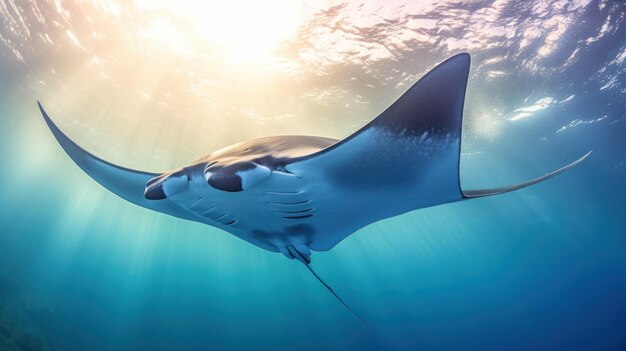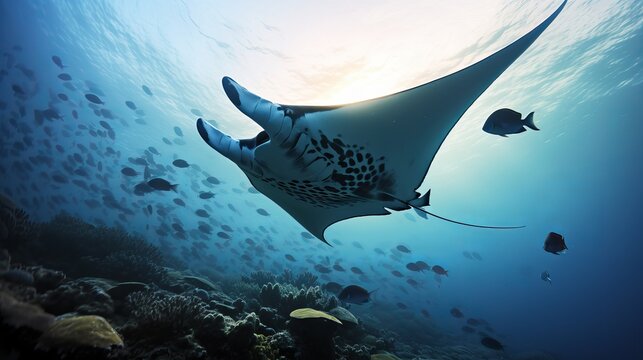Manta Birostris, commonly known as the Giant Manta Ray, is a magnificent marine creature that roams the world’s oceans with grace and elegance. With its immense size, distinctive appearance, and gentle demeanor, the Giant Manta Ray captivates the hearts of marine enthusiasts and conservationists alike. Let’s dive into the fascinating world of Manta Birostris and uncover the wonders of this majestic giant of the sea.

Appearance and Characteristics:
The Giant Manta Ray is one of the largest rays in the ocean, boasting an impressive wingspan that can exceed 7 meters (23 feet) from tip to tip. Its flattened body is adorned with a unique coloration pattern, featuring dark dorsal surfaces and lighter ventral surfaces, which help camouflage it from predators and prey alike. The most distinguishing feature of the Giant Manta Ray is its cephalic fins, which are elongated and give the appearance of “horns” on either side of its head.
Habitat and Distribution:
Giant Manta Rays are found in tropical and subtropical waters around the world, inhabiting both coastal and pelagic environments. They are commonly sighted in areas with high plankton abundance, such as coral reefs, oceanic islands, and upwelling zones. While they prefer warmer waters, they have been known to venture into temperate regions during seasonal migrations.
Behavior and Feeding Habits:
Despite their imposing size, Giant Manta Rays are gentle giants known for their peaceful demeanor and graceful movements underwater. They are filter feeders, using their large, paddle-like pectoral fins to glide effortlessly through the water while filtering plankton and small fish from the water column. Their mouths, located on the ventral side of their bodies, are equipped with specialized gill rakers that trap microscopic organisms as they swim.
Social Structure and Reproduction:
Giant Manta Rays are solitary animals for much of their lives, but they occasionally gather in large aggregations during feeding or mating events. Little is known about their reproductive behavior, but it is believed that they give birth to live young after a gestation period of around one year. Female Giant Manta Rays typically give birth to a single pup every two to three years, with the young rays being born fully developed and capable of swimming independently.

Conservation Status and Threats:
Despite their awe-inspiring presence, Giant Manta Rays face numerous threats from human activities, including overfishing, habitat degradation, and entanglement in fishing gear. They are often caught as bycatch in commercial fisheries targeting other species, and their gill plates are sought after in traditional Asian medicine markets. Additionally, pollution and climate change pose significant threats to their habitat and food sources, further exacerbating their conservation status.
Conservation Efforts:
Efforts to protect Giant Manta Rays and their habitats are underway around the world, including the establishment of marine protected areas, fisheries regulations, and ecotourism initiatives. Conservation organizations work to raise awareness about the importance of protecting these majestic creatures and advocate for measures to mitigate threats such as overfishing and habitat destruction. By promoting responsible fishing practices and sustainable tourism, we can help ensure the long-term survival of the Giant Manta Ray and preserve the biodiversity of our oceans for future generations to enjoy.
The Giant Manta Ray, with its awe-inspiring size and gentle nature, serves as a symbol of the magnificence and fragility of the ocean ecosystem. As ambassadors of the sea, these majestic creatures wdbos inspire wonder and appreciation for the beauty and diversity of marine life. By working together to address the threats facing Giant Manta Rays and their habitats, we can ensure that they continue to grace our oceans with their presence for generations to come.
Exploring the Advantages and Disadvantages of Manta Birostris: Understanding the Role of Giant Manta Rays in Marine Ecosystems
Giant Manta Rays (Manta birostris) are majestic creatures that inhabit the world’s oceans, captivating the imagination of marine enthusiasts and researchers alike. While celebrated for their graceful presence and ecological significance, Manta Birostris also face challenges and limitations in their environment. Let’s delve into the advantages and disadvantages of these magnificent creatures to gain a deeper understanding of their role in marine ecosystems.

Advantages of Manta Birostris:
- Eco-Tourism Attraction: Giant Manta Rays serve as a major draw for eco-tourism activities, attracting divers and snorkelers to destinations where they are commonly sighted. This contributes to local economies and promotes conservation efforts by raising awareness about the importance of protecting marine habitats.
- Bioindicators of Ecosystem Health: As filter feeders, Giant Manta Rays are sensitive to changes in water quality and plankton abundance, making them valuable indicators of ecosystem health. Monitoring their populations and behavior can provide valuable insights into the overall condition of marine environments.
- Plankton Control: Manta Birostris play a crucial role in controlling plankton populations, particularly in areas with high plankton abundance. By filtering large volumes of water as they feed, they help regulate planktonic communities and maintain ecological balance within their habitat.
- Diving and Research Opportunities: The presence of Giant Manta Rays in certain locations provides opportunities for scientific research and conservation initiatives. Researchers study their behavior, migration patterns, and reproductive biology to better understand their ecological role and inform conservation strategies.
Disadvantages of Manta Birostris:
- Vulnerability to Overfishing: Giant Manta Rays are vulnerable to overfishing and bycatch in commercial fisheries targeting other species. They are often caught accidentally in fishing gear, leading to population declines and disruptions in marine food webs.
- Habitat Degradation: Habitat degradation and destruction, including coral reef degradation and coastal development, pose significant threats to Manta Birostris populations. Loss of suitable habitat can restrict their movements and limit access to food sources.
- Entanglement in Marine Debris: Manta Birostris are at risk of entanglement in marine debris such as fishing nets, lines, and plastic pollution. Entanglement can cause injuries, impair mobility, and lead to mortality, particularly in areas with high levels of marine debris.
- Human Disturbance: Increased human activities, such as boat traffic and underwater tourism, can disturb Giant Manta Rays and disrupt their natural behaviors. Excessive disturbance can cause stress, reduce feeding efficiency, and alter habitat use patterns.
Conclusion:
While Giant Manta Rays offer numerous benefits to marine ecosystems and human communities, they also face significant challenges and threats in their environment. By addressing these disadvantages and implementing conservation measures to protect Manta Birostris and their habitats, we can ensure their continued survival and preserve the biodiversity and ecological integrity of our oceans. Collaborative efforts between governments, conservation organizations, and local communities are essential to safeguarding these magnificent creatures for future generations to admire and cherish.
Read More Article About “The Colosseum: Icon of Ancient Rome and Timeless Wonder“



























